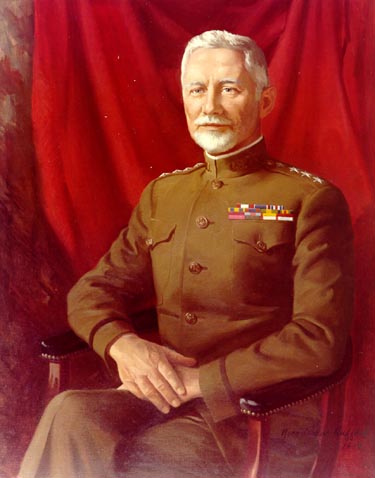
Peyton Conway March was born in Easton, Pennsylvania, on 27 December 1864; attended Lafayette College, 1880–1884, and graduated from the United States Military Academy, 1888; was commissioned an additional second lieutenant and assigned to the 3d Artillery, June 1888, advancing to second lieutenant in November; performed routine garrison duties in Washington, D.C., and California, 1888–1896; married Josephine Smith Cunningham, 1891 (deceased 1904); was promoted to first lieutenant and assigned to the 5th Artillery, 1894; attended the Artillery School at Fort Monroe, 1896–1898; organized and was designated captain of the Astor Battery, 1898; commanded it in the Philippines campaign and in the capture of Manila, 1898–1899; was aide to General Arthur MacArthur, 1899; was promoted to major, 33d Volunteer Infantry, July 1899, and participated in numerous operations of the Philippine Insurrection; was promoted to temporary lieutenant colonel, 1900; was a provincial governor and commissary of prisoners, 1900–1901; was reverted to regular captaincy in artillery, 1901, and commanded the 19th Battery, Field Artillery, at Fort Riley, to 1903; was a member of the new War Department General Staff, 1903–1907, and a military observer to the Japanese Army during the Russo-Japanese War, 1904; was promoted to major, January 1907, and served on the Artillery Board; commanded the 1st Battalion, 6th Field Artillery, 1907–1911; was detailed to the Adjutant General’s Department and served successively as adjutant of Fort Riley, the Department of the Missouri, the Central Department, the 2d Division, and at department headquarters in Washington, D.C., 1911–1916; was promoted to colonel, July 1916, and commanded the 8th Field Artillery on the Mexican border, 1916–1917; was promoted to brigadier general, June 1917, and placed in command of the 1st Field Artillery Brigade, 1st Division, American Expeditionary Forces; was promoted to major general in the National Army, August 1917, and commanded the first Army and nondivisional artillery, American Expeditionary Forces, June 1917; was promoted to major general in the regular establishment, September 1917; was again assigned to the General Staff and was acting chief of staff, March–May 1918; was promoted to temporary general, May 1918; was chief of staff of the United States Army, 19 May 1918–30 June 1921; established the primacy of the chief of staff in the Army hierarchy; presided over the buildup of American forces in World War I; centralized control over supply; created an Air Service, Tank Corps, and Chemical Warfare Service; and supervised the demobilization at war’s end; retired as a major general, November 1921, and was advanced to general on the retired list, June 1930; married Cora V. McEntee, 1923; died in Washington, D.C., on 13 April 1955.
The Artist
Nicodemus David Hufford (1915–) was born in Columbus, Ohio. In the 1930s he studied his chosen profession at the Chicago Art Institute, the Chicago Academy of Fine Arts, and the Chicago Professional School and American Academy, and in the early 1940s he served an apprenticeship under two top illustrators, Haddon Sundblom and Harry Anderson. He maintains studios at Martinsville, Virginia, and New York City. Hufford has painted portraits of a number of leading American families, including the Rockefellers, du Ponts, and Dukes, and his work hangs in many homes in the United States and abroad. His portrait of General Peyton C. March was created from photographic images of the World War I chief of staff.
Peyton Conway March
By Nicodemus David Hufford
Oil on canvas, 40" x 32", 1974
[108]

[109]
page updated 30 April 2001